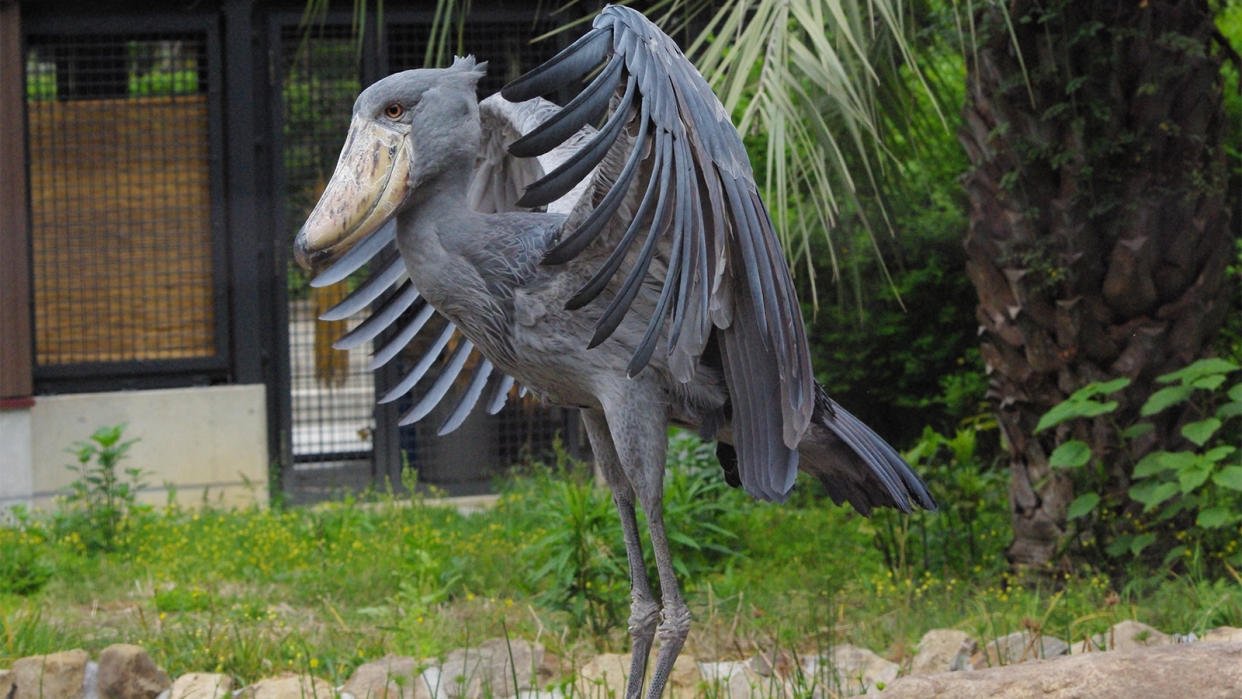The Shoebill Stork: One Freaky and Formidable Bird

Gasp and behold the rare Balaeniceps rex. Also known as a whalehead, or the whale-headed stork, the breathtaking, prehistoric-looking shoebill stork has frightened and charmed its human observers in equal measure.
These imposing birds sport a beak that has reminded many of a dutch clog, hence the popular name. As we'll see, their beaks are only one aspect of what makes them a unique and fascinating species.
Changes in Shoebill Classification
Based on its morphology, the shoebill was classified with storks from the 1850s through the 1980s. However, more recent DNA research finds that shoebills are actually biochemically more similar to herons and anatomically more closely related to pelicans.
In any case, these impressive wading birds now have their own family, Balaenicipitidae, which is one of the perks of being an oddity of the animal kingdom.
Home of the Shoebill Storks
The shoebill is native to the remote, marshy freshwater swamps of East Africa, from South Sudan to Zambia. It prefers to do its hunting in the floating vegetation and shallow water, where it patiently seeks unsuspecting prey.
While not technically an endangered species, habitat loss in East Africa — mostly from farming and industry, abetted by the increasing pressures of climate change — has threatened their survival. They are now considered "Vulnerable," with a small and declining population.
Shoebills: Big Birds With Big Appetites
With the adult birds weighing anywhere from 12 to 15 pounds (5.4 to 6.8 kg) and standing up to 5 feet (1.5 meters) tall, the largest shoebill's boast a wingspan of 8 feet (2.4 meters).
This steely-eyed, aloof and gawky bird hangs out in reedy wetlands where it can nosh on its favorite foods, namely fish (lungfish, tilapia, catfish), frogs, water snakes, monitor lizards and baby crocodiles.
Hunting and consuming their food is accomplished using the shoebill's formidable, 7-inch (18-centimeter) beak. The sharp edges of the beak, which terminate in a sharp, nail-like point, are good for skewering and cutting small and large prey alike.
Imposing but Harmless (to Humans)
If you do happen to encounter a shoebill in the wild, just relax and take in the spectacle.
Docile around humans and known for its slow movements and tendency to stand still for long periods of time, it'll probably just stand there and stare you down with its yellow eyes. This should give you plenty of time to harness your inner birder and do a photo shoot — from, say, at least 10 feet (3 meters) away.
It might also vocalize, the sound of which has been compared to a jackhammer or a machine gun. Startling and unusual, yes, but this bill clattering is intended for communication with other shoebills, especially during the nesting season.
The bewildering sound is made from clacking together the lower and upper mandible of its exceptionally large beak.
Shoebills as Partners and Parents
A monogamous bird that can live up to 35 years, the shoebill finds its mate at a young age and aggressively defends its partner against rivals. Breeding pairs participate in building their nest, which is a kind of floating barge that can be as large as 10 feet (3 meters) wide and 9 feet (2.7 meters) deep.
Shoebills are solitary and territorial creatures who need lots of personal space. In the wild, there are usually less than three nests per square kilometer, which is unusually sparse for other wading birds. A breeding pair of shoebills will even hunt on opposite ends of their hunting range.
During breeding season, the females lay two or three eggs, but they will raise only one chick. The others will often perish from neglect (if they aren't consumed by their siblings). Young shoebills have a Darwinian dark side and, alas, will sometimes kill their younger siblings.
The Shoebill: Weird and Precious
These increasingly rare birds (there are estimated to be only about 3,300 to 5,300 specimens of Balaeniceps rex left in the wild) don't spend too much time airborne. Shoebills will fly (a mere 150 flaps per minute) anywhere from 500 to 1,000 feet (152 to 305 meters) at a time, with most flights in the 65-foot (19.8-meter) range.
This is another reason why habitat loss is such an issue: With a need for a wide territory, and the rarity of more than one chick surviving to adulthood, they face an uphill battle to survive in today's rapidly changing climate.
Fierce in the wild, the dauntless shoebill has been known to fight Nile crocodiles (one of the largest crocodiles out there) — to get to their delicious babies, and to fraternize with hippos whenever possible, as the sheer enormity of hippos forces yummy shoebill snacks to the water's surface.
And now for the punchline: This crocodile-decapitating, machine gun-impersonating, feathered Goliath is also a leg defecator. Yep, they poop on their own legs. Liquid stool keeps the shoebill cool.
Anybody got a problem with that?
Now That's Interesting
Shoebill eggs and chicks are prized targets for poachers who make big bucks supplying the illegal live bird trade. Enthusiasts in Saudi Arabia and Dubai are reported to pay $10,000 or more to add a shoebill to their collection. Zambia's Department of National Parks and Wildlife in partnership with a nonprofit conservation organization began a program in 2012 to guard the endangered shoebill during mating season.
Original article: The Shoebill Stork: One Freaky and Formidable Bird
Copyright © 2024 HowStuffWorks, a division of InfoSpace Holdings, LLC, a System1 Company

